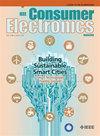Next Generation Intelligent Traffic Signal Control: Empowering Electronics Consumers With Edge-AIoT Capabilities
IF 4.3
2区 计算机科学
Q1 ENGINEERING, ELECTRICAL & ELECTRONIC
引用次数: 0
Abstract
Traffic congestion has become a major issue that is being faced by the majority of road users. The increasing vehicle usage, and the lack of space and funds to construct new transport infrastructure, further complicates the issue. In this scenario, it is important to come up with an intelligent and economical solution that improves the quality of road users’ service. The problem with the traffic handling framework is signal timings are fixed which is not adaptive to the density of vehicles. To address this issue we propose an Edge-Augument Artificial Intelligence of Things (AIoT) road user cooperation for traffic management. The proposed system efficiently utilizes electronic devices to learn and adapt to changing traffic conditions in real-time. By optimizing the traffic signal timings based on the actual traffic conditions, adaptive systems reduce delay, improve traffic flow, reduce fuel consumption and pollution, and improve the electronics consumers’ and road users’ experiences. The proposed system has been tested with real-time experiments by integrating Electronic devices like cameras, smartphones, and AGX Xavier (edge device) with Cloud (ThingSpeak). The proposed system is verified by simulating the proposed system in the SUMO traffic simulator and its reliability is concluded by comparing the waiting time, depart delay, running, and halt time with the existing traditional method.下一代智能交通信号控制:为电子产品消费者提供边缘aiot功能
交通挤塞已成为大多数道路使用者面临的一个主要问题。车辆使用量的增加,以及建设新交通基础设施的空间和资金的缺乏,使问题进一步复杂化。在这种情况下,重要的是要提出一个智能和经济的解决方案,提高道路使用者的服务质量。交通处理框架存在的问题是信号配时是固定的,不能适应车辆密度。为了解决这一问题,我们提出了一种用于交通管理的边缘增强物联网(AIoT)道路使用者合作。该系统有效地利用电子设备实时学习和适应不断变化的交通状况。自适应系统通过根据实际交通状况优化交通信号配时,减少延误,改善交通流量,降低油耗和污染,改善电子产品消费者和道路使用者的体验。该系统已通过将相机、智能手机和AGX Xavier(边缘设备)等电子设备与云(ThingSpeak)集成在一起的实时实验进行了测试。通过在SUMO交通模拟器上对所提系统进行仿真验证,并与现有传统方法进行了等待时间、发车延误、运行时间和停车时间的比较,得出了所提系统的可靠性。
本文章由计算机程序翻译,如有差异,请以英文原文为准。
求助全文
约1分钟内获得全文
求助全文
来源期刊
CiteScore
7.70
自引率
9.30%
发文量
59
审稿时长
3.3 months
期刊介绍:
The main focus for the IEEE Transactions on Consumer Electronics is the engineering and research aspects of the theory, design, construction, manufacture or end use of mass market electronics, systems, software and services for consumers.

 求助内容:
求助内容: 应助结果提醒方式:
应助结果提醒方式:


